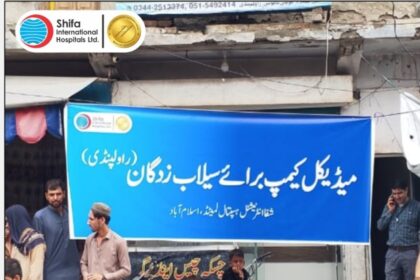Dr. Waseem Ur Rahman Highlights Medical Breakthroughs and Holistic Care for SMA Patients at Strive Foundation Conference
Islamabad — Dr. Waseem Ur Rahman, Associate Consultant in Pediatric Neurology at Shifa International Hospital, delivered an insightful presentation titled “A Genetic Journey from Weakness to Breakthroughs” during the Strive Foundation’s national conference on Spinal Muscular Atrophy (SMA). His address focused on the latest advancements in diagnosis, treatment, and long-term care for SMA patients in Pakistan.
Dr. Waseem, who holds an MBBS from Khyber Medical College, an FCPS in Pediatrics from Aga Khan University Hospital, and an FCPS in Pediatric Neurology from the University of Child Health Sciences Lahore, began by expressing gratitude to the Strive Foundation and commending earlier speakers, Dr. Asim Ijaz and Dr. Maryam Tariq, for setting a strong foundation for his discussion.
He contrasted the past with the present, noting that only a few years ago, there was little doctors could offer parents asking about their child’s future with SMA. Today, however, there is genuine hope thanks to scientific progress and organizations like Strive Foundation. He said that while many parents fail to notice the early, subtle signs of SMA, doctors should look for key indicators such as tongue fasciculations and hypotonia (low muscle tone). He confirmed that genetic testing for SMA is available in Pakistan through Aga Khan University, with a turnaround time of about seven to ten days.
Discussing treatments, Dr. Waseem explained that three major therapies are now accessible worldwide — Nusinersen (Spinraza), Risdiplam (Evrysdi), and Zolgensma. He described Nusinersen as an intrathecal injection requiring lifelong administration and Risdiplam as an oral medicine that activates the SMN2 gene to compensate for the defective SMN1 gene. Highlighting remarkable progress, he said: “Children with Type 1 SMA — who historically would not see their first birthday — are now sitting up. It’s a remarkable achievement.” He acknowledged Strive Foundation for helping provide this treatment to his own patients, many of whom are now thriving.
He also spoke about Zolgensma, a one-time gene therapy that can potentially cure SMA by using a modified adeno-virus to replace the faulty SMN1 gene. However, he pointed out its prohibitive cost of $2.2 million, making it inaccessible to most families in Pakistan.
Dr. Waseem emphasized that medication alone is insufficient and that holistic support is crucial for improving the quality of life of SMA patients. He outlined the importance of physical and occupational therapy, nutritional support (including nasogastric feeding to build muscle strength), and respiratory support using BiPAP machines and cough-assist devices.
Concluding his address, he expressed heartfelt gratitude to the Strive Foundation and its donors, saying, “I have seen it first-hand — my patients, who couldn’t even afford hospital fees, are now on Risdiplam and thriving. It’s an incredible transformation.”
During the Q&A session, Dr. Waseem answered several technical and ethical questions. On prenatal diagnosis, he explained that families with a history of SMA can undergo chorionic villus sampling (CVS) between the 10th and 12th week of pregnancy. The test is available at Aga Khan University discounted options for low-income patients under the welfare system. He also mentioned the Genetic Resource Center (GRC) in Rawalpindi as another testing facility.
On misdiagnosis, he confirmed that SMA is often mistaken for Cerebral Palsy (CP). The key distinction, he said, is that SMA patients are cognitively alert, maintaining normal eye contact, social smiles, and babbling — unlike many CP patients.
Addressing challenges in Pakistan’s public healthcare system, Dr. Waseem pointed out that neurologists in government hospitals often see up to 350 patients in a single OPD session, leaving little time for detailed communication with families. He said this heavy workload limits doctors’ ability to provide proper counseling and emotional support.
When asked about SMA alert cards, he said such initiatives are rare in Pakistan. He recalled seeing “sick day plan” cards during his training at Aga Khan University for patients with metabolic disorders but said that similar tools for SMA and epilepsy are not yet in use.
Dr. Waseem’s presentation was recognized for bridging scientific understanding with compassion and practical healthcare guidance. His emphasis on genetic testing, holistic care, and support networks underscored the urgent need for systemic reforms to help SMA patients and their families in Pakistan.











